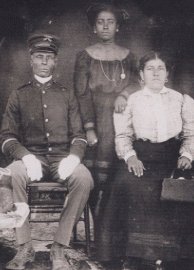Work, Marriage, Christianity
Many of these early slaves were American Indians, mostly Algonquian-speakers of coastal Virginia and North Carolina. By the 1680s, English settlers routinely kidnapped Native American women and children in the coastal plains of North Carolina and Virginia. This Native American slave trade involved a number of colonies, including Virginia, Carolina, Pennsylvania, Massachusetts, Jamaica, Barbados, St. Kitts, and Nevis. So many Indian slaves were traded to Pennsylvania that a law was passed in 1705 forbidding the importation of Carolina Indian slaves. This was done in part because many of the slaves were Tuscarora who were aligned militarily with the Iroquois Confederacy, which threatened to intervene to stop the trade.
From 1680 to 1715, the English sold thousands of Indians into slavery, some as far away as the Caribbean. Indian slavery, however, had many problems, not the least of which were Indian attacks, and by 1720, most colonies in North America had abandoned it for African slavery. In 1670, Virginia passed a law defining slavery as a lifelong inheritable “racial” status. After the passage of this law many “black-Indians” found themselves classified as black and forced into slavery.
In the fields and homes of colonial plantations, mutually enslaved African Americans and American Indians forged their first intimate relations. In spite of a later tendency in the Southern colonies to differentiate the African slave from the Indian, chattel slavery was built on a preexisting system of Indian slavery.
Even though the arrival of Africans in 1619 began to change the face of slavery in North America from “tawny” Indian to “blackamoor” African, Indian slaves were exported throughout the Caribbean often in trade for Africans. As the 18th century dawned the slave trade in American Indians was so serious that it eclipsed the trade for furs and skins and had become the primary source of commerce between the English and the South Carolina colonials (Minges 2002:454).

The Daniels Family, 20th Century Texas descendants of Florida AfraIndians called the Black Seminole.
During this transitional period, Africans and Americans Indians shared the common experience of enslavement. They worked together, lived together in communal quarters, produced collective recipes for food, shared herbal remedies, myths and legends and in the end they intermarried. Africans had a disproportionate numbers of males in their population while Native American women and children were disproportionately enslaved. American Indians males were shipped to the Caribbean, died in wars or of European diseases. As traditional societies in the Southeast were primarily matrilineal, African males who married American Indians women often became members of the wife’s clan and of her nation
Francis Le Jau described a prophetic Christianity that developed in the African American community in the Carolina colony. Because of their close association with Americans Indians through work and marriage, in these areas of the South the Mvskokes were instructed in the Christian religion by multilingual African American “linksters.” Some scholars argue that the African Americans also passed on a spiritually inspired critical view of the English that eventually led to American Indian rebellion.
The 1740 slave codes of South Carolina served to blur the distinction between African, American Indian and the children of their intermarriage, declaring:
All negroes and Indians, (free Indians in amity with this government, and negroes, mulattoes, and mustezoses, who are now free, excepted) mullatoes and mustezoes who are now, or shall hereafter be in this province, and all their issue and offspring…shall be and they are hereby declared to be, and remain hereafter absolute slaves (Hurd 1862:303 as cited in Minges 2002:455)
Even so, the next century would see the development of independent mixed-blood communities, the most notable those that participated in the African-Seminole Indian Wars in Florida.
Most of the early records of the missionaries note that enslaved African American living in American Indian communities were among their first converts to Christianity. Some of these religious leaders were African or Aframeridian who, during the Colonial Period, lived among Southeastern Mvskoke, Seminole, Cherokee, Choctaw, and Chickasaw (Eighth Annual report 1818:16, Ninth Annual Report 1819:19).
In the cultural nexus of 18th century “integrated community of the early American frontier,” African and American Indian peoples shared a common religious experience. Galphintown in South Carolina was such a plantation community and trading center. Interestingly, the first recorded Negro Baptist church was organized nearby at Silver Bluff, South Carolina in 1773 or 1775 (Brooks 1922:15). Members of Galphin’s family were patrons of the church at Sliver Bluff (Minges 20012:463).






